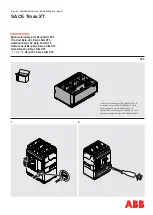
Description
9229 9947 176 0C
27
2013-03-28
Instantaneous release H83 Opt. (Y2) 3AX601
The instantaneous release H83 Opt. is a protection relay and was specially
developed for use in vacuum circuit-breakers with 16
2
/
3
Hz for rail applications, in
order to achieve the shortest possible break time.
Since the arcing time in rail networks is three times longer, the use of a special
protection relay together with the rapid release is intended to produce a statistical
short-circuit cut-off already after a half-wave.
Closing time
Due to its type of construction and the materials used, it has an extremely short
operating time of < 10 ms, at a very small magnet stroke of 2.5 mm.
For use in the 3AH47 vacuum circuit-breaker a dynamic method of working is
therefore selected:
Because the tripping stroke is not sufficient for static tripping of the opening
latch, a tripping lever is quickly accelerated and actuates the latch with its kinetic
energy.
Break time
With the instantaneous release (54.2), the vacuum circuit-breaker reaches break
times of no more than 20 ms, the vacuum circuit-breakers for rail applications
especially designed for this purpose reach even < 17 ms.
Fig. 36
Instantaneous release H83 Opt.
Actuation
The low internal resistance of the tripping coil normally does not allow direct
operation at the supply voltage because the large current levels in particular from
auxiliary switches cannot be controlled. The release is thus fed from a capacitor
bank with an electrolytic capacitor connected in parallel. This provides several
advantages:
• The supply system only has to make available the minimal charging current.
• Because of the physical proximity of the capacitors to the release, only minimal
voltage losses occur.
• The auxiliary switch only needs to shut off the residual current of the almost
discharged capacitors after tripping has occurred.
Transistor switch
(MOSFET) as a coupling
device
Nevertheless, the closing circuit is loaded with the high tripping current – in particular
at 60 V. With a protection relay that is set up very far away, unreliable line losses
can therefore occur. Therefore, a faster transistor switch (MOSFET) must be used
as a coupling device, which increases the response time by only a few
μ
s and must
always be used at 60 V.
This tripping solenoid is not designed for continuous operation and can be ordered
for voltage levels 60 V DC, 110 V DC and 220 V DC.













































